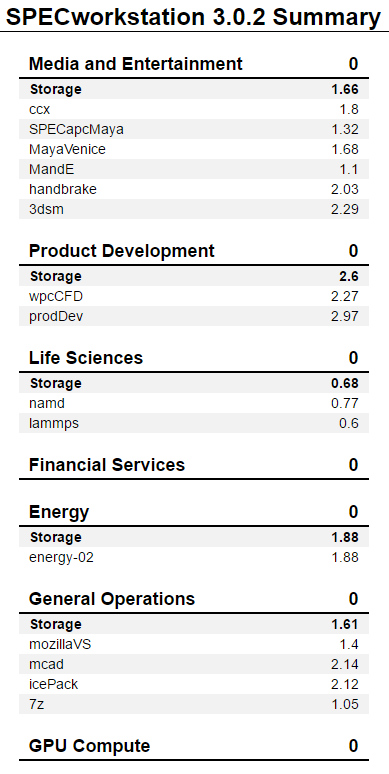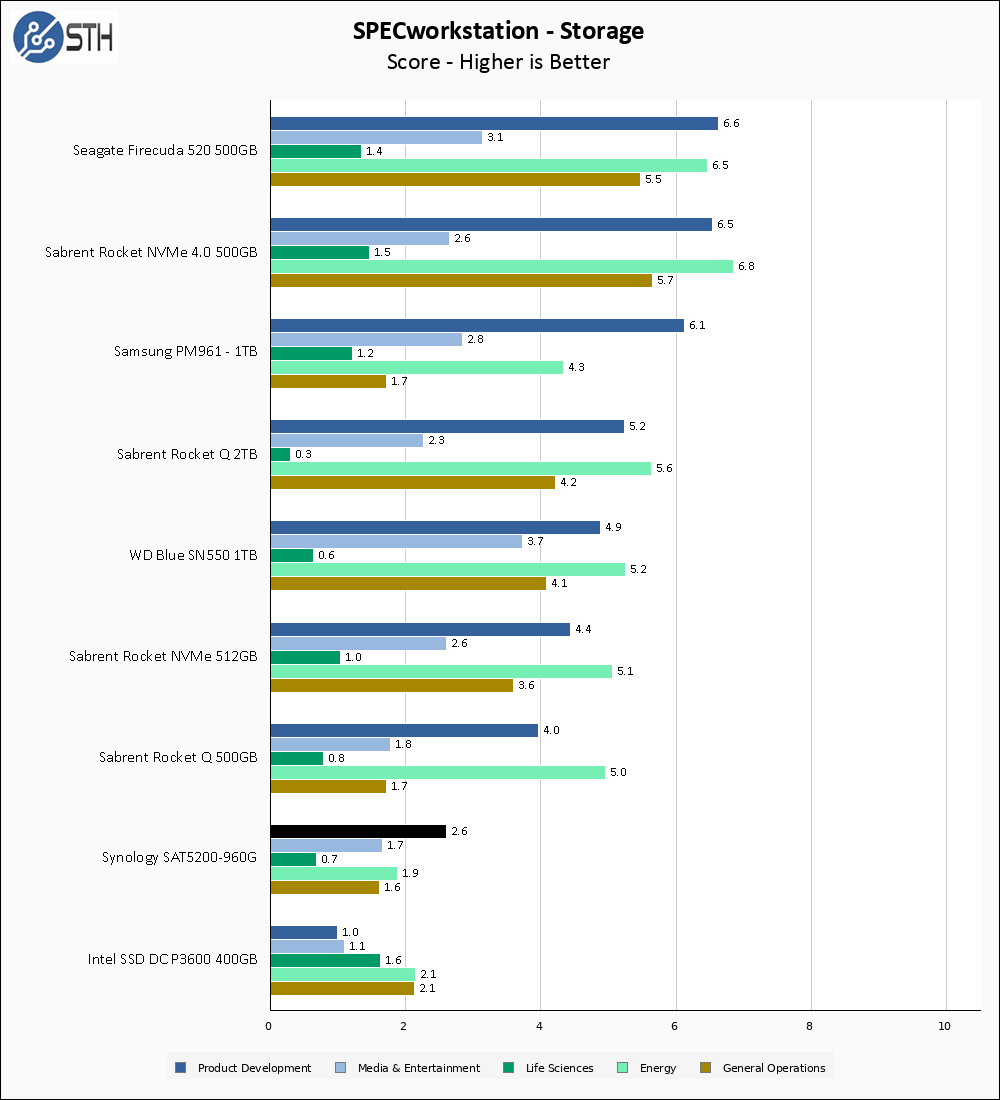SPECworkstation 3.0.2 Storage Benchmark
SPECworstation benchmark is an excellent benchmark to test systems using workstation type workloads. In this test, we only ran the Storage component, which is 15 separate tests.


The SAT5200-960G performs pretty well on the SPEC Storage benchmark. While the chart is ordered based on the Product Development score, in some of the other benchmarks like Life Sciences the Synology drive manages to put up wins against drives that on paper should be much faster.
Final Words
The Synology SAT5200-960G is a very focused product aimed specifically at all-flash NAS arrays running on Synology hardware. We have examined it independently of that ecosystem, which is perhaps unfair to the drive. Personally I have still come away impressed. One area that is less impressive is the asking price; this 960GB drive is priced at $350 on Amazon as of the time of writing. The Seagate Ironwolf 110 960GB drive, which mostly has feature parity with the SAT5200-960G, is only $240, while the lower-class WD Red 1TB SSD is only $130-150 (review coming soon.) Considering all three drives are nominally positioned to attack the same market, coming in at the top of the $130 to $350 price range is perhaps an unfortunate place to be, since price sensitivity is often a factor when considering an all-flash NAS array.
With that said, it is hard to argue that you are not getting what you pay for. This is the most durable SATA SSD we have reviewed at this capacity point. Additionally, many potential buyers might wish to avoid the potential finger-pointing of dealing with multiple vendors in a troubleshooting scenario; if both your NAS and your SSDs are built by Synology, then they would be your single point of contact for any tech support scenario.
Built on proven components, with enterprise-class overprovisioning, power loss protection, and guaranteed integration and compatibility with Synology NAS products, the SAT5200-960G is a solid first effort at SSDs produced by Synology. Out of the context of installation in a Synology NAS device, it is difficult to recommend the purchase of this drive over something like an Ironwolf 110, but if you are populating an all-flash Synology NAS this is definitely a drive to consider.




To avoid a race to the bottom in which manufacturers lower the quality of their products while optimising a simple metric used for performance comparisons, it would be nice to devise a way to test power-loss protection as well as compare how much flash really is reserved for wear leveling and endurance. Power consumption under various loads and heat generation would also be useful.
“Our testing uses the Synology SAT5200-960G as the boot drive for the system, installed in the M.2_1 slot on the motherboard.”
That must have been quite a feat.
WTH,
Indeed :) I’ve fixed it, it’s supposed to be SATA6G_1. Thanks!
Eric,
Patrick and I went back and forth a bit on the reserved area of flash. While we felt pretty confident with the 128GB NAND packages resulting in 320GB of spare area, we were unable to get official confirmation from anyone. Call it an educated guess.
As for power, the power usage of almost any single SSD is unfortunately within the margin of error of my ability to measure it, especially if I intend to distinguish load power of the drive from the rest of the power in use on my system. For SATA drives, I could in theory attach them to their own separate power supply and measure them independently from the rest of the system, but I do not review many SATA/SAS SSDs so it is not a path I took.
Thank you to STH for doing storage. I saw other reviews of this drive that didn’t mention the 10 NAND packages. That’s a great insight that you’ve covered.
@Will Thanks for the clarification and quick response.
I think a good 3rd-year electrical engineering student could wire up a harness with an inline amp meter to accurately measure the power draw of a SATA SSD. A similar device should be possible for m.2 as well. While the depth of reporting on Serve the Home is always good, this would be a way to improve it and in my opinion quite interesting.
On first impressions, this SSD looks like a very nice upgrade for an old laptop with an aging 160 GB hard drive in need of TLC, although frankly it’s probably far too expensive for my lacking income given that its intended use case is in NASes. I noticed a sizable number of unpopulated chip positions and was wondering why, but then I saw your chart showing capacities up to 1.92 TB and that would explain that. It would be neat to see future ones go up to 4 TB without compromising on what looks to be a fairly rock-solid design reliability-wise.
Stephen,
This drive is likely very much overkill for a simple client laptop drive. I would look at more consumer oriented drives for sure. You can spend 1/3 the money for the same capacity since you will not be paying for the features you don’t need.
Will,
as some of us know, this SSD is targeted primary to NAS environment.
Why those useless tests, without an added value for the NASes?
Why not:
– ext4/btrfs based FS tests?
– diff RAID scenarios (regular or SHR)?
– RANDOM I/O only tests? Because sequential outputs you can put into trash.
– virtualized environment (VMM, Docker) … one of the target for this SSD
– real test bunch ( mixed file sizes wit near to regular size)
Then this review will be useful. Otherwise you can write just = this is an expensive drive for such benchmark eaters.
Price is ridiculous even for high-end DWPD and PLP.
At U$350 (two places) it’s less than the Ironwolf, vote with your wallet.
Will Taillac,
Thank you for replying to my comment. Perhaps you’re correct in the points you made. However, my idea of a decent reliable SSD would kind of include having a really long lifespan. I’m not certain that consumer grade SSDs are able to deliver that. I’ve read about the use of MLC, TLC and now QLC technology and how the life in write/erase/rewrite cycles is significantly lower than that for the earlier SLC technologies. Also, they have been billed as being not as fast, performance-wise, as the SLC-based SSDs. Maybe I’m behind the curve. I just think it would be nice to be able to have an SSD with both huge capacity AND a lifespan at least equal to that of a traditional spinning-platter drive.
Stephen,
For most common, consumer-level use case scenarios, a quality consumer-grade SSD made today should outlast its usable lifetime. An example, the 970 EVO 250GB drive I have as my personal workstation boot drive is around 1 year old, and on my computer where I work and play 12+ hours a day it currently has 12.4TB of total writes in that time. At my current pace, after the 5 year warranty is completed I will have written ~62TB of data to the drive, while its rated endurance in those 5 years is 150TB. Meanwhile, by the time 2024 comes around, a 250GB drive will be puny in size (it already almost is).
Unless a drive is subjected to what I would describe as ‘intense’ or ‘server-like’ workloads, common consumer uses of SSD drives for boot volumes and games and such are unlikely to run afoul of endurance limits of most modern SSDs.